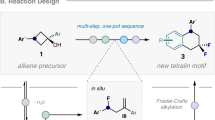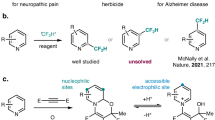Abstract
Fluorination has gained an increasingly important role in drug discovery and development. Here we describe a versatile strategy that combines cytochrome P450–catalyzed oxygenation with deoxofluorination to achieve mono- and polyfluorination of nonreactive sites in a variety of organic scaffolds. This procedure was applied for the rapid identification of fluorinated drug derivatives with enhanced membrane permeability.



Similar content being viewed by others
References
Muller, K., Faeh, C. & Diederich, F. Science 317, 1881–1886 (2007).
Park, B.K., Kitteringham, N.R. & O'Neill, P.M. Annu. Rev. Pharmacol. Toxicol. 41, 443–470 (2001).
Bohm, H.J. et al. ChemBioChem 5, 637–643 (2004).
Kirsch, P. Modern Fluoroorganic Chemistry (Wiley-VCH, Weinheim, Germany, 2004).
Shimizu, M. & Hiyama, T. Angew. Chem. Int. Ed. 44, 214–231 (2005).
Ma, J.A. & Cahard, D. Chem. Rev. 104, 6119–6146 (2004).
Bobbio, C. & Gouverneur, V. Org. Biomol. Chem. 4, 2065–2075 (2006).
Günter, H. J. Fluor. Chem. 125, 875–894 (2004).
Iacazio, G. & Réglier, M. Tetrahedron Asymmetry 16, 3633–3639 (2005).
Warman, A.J. et al. Biochem. Soc. Trans. 33, 747–753 (2005).
Fasan, R., Meharenna, Y.T., Snow, C.D., Poulos, T.L. & Arnold, F.H. J. Mol. Biol. 383, 1069–1080 (2008).
Mikolajczyk, M., Mikina, M. & Zurawinski, R. Pure Appl. Chem. 71, 473–480 (1999).
Fujisawa, H., Fujiwara, T., Takeuchi, Y. & Omata, K. Chem. Pharm. Bull. (Tokyo) 53, 524–528 (2005).
Singh, R.P. & Shreeve, J.M. Synthesis 17, 2561–2578 (2002).
Landwehr, M. et al. J. Am. Chem. Soc. 128, 6058–6059 (2006).
Leuchtenberger, S., Beher, D. & Weggen, S. Curr. Pharm. Des. 12, 4337–4355 (2006).
Feher, M. & Schmidt, J.M. J. Chem. Inf. Comput. Sci. 43, 218–227 (2003).
Wong, T.S., Arnold, F.H. & Schwaneberg, U. Biotechnol. Bioeng. 85, 351–358 (2004).
Hamman, M.A., Thompson, G.A. & Hall, S.D. Biochem. Pharmacol. 54, 33–41 (1997).
Acknowledgements
We are grateful to M. Shahgholi for assistance with the LC-MS and HRMS analyses. This work was supported by US National Institutes of Health grant GM068664 and US Department of Agriculture grant 2006-35505-16660 to F.H.A. and by the Jacobs Institute (Caltech). A.R. acknowledges the Deutsche Forschungsgemeinschaft for financial support.
Author information
Authors and Affiliations
Contributions
R.F. and F.H.A. conceived the project; R.F. and A.R. performed the experiments; all authors discussed the results; R.F. wrote the paper with help and edits from F.H.A. and A.R.
Corresponding author
Ethics declarations
Competing interests
R.F. and F.H.A. filed an international patent application (WO/2008/016709) entitled “Methods and systems for selective fluorination of organic molecules.” Some of the P450 enzymes described in this work are available commercially from Codexis, Inc. F.H.A. is a minor shareholder of Codexis and serves on the Codexis Science Advisory Board.
Supplementary information
Supplementary Text and Figures
Supplementary Figures 1–7, Supplementary Tables 1 and 2, and Supplementary Methods (PDF 1238 kb)
Rights and permissions
About this article
Cite this article
Rentmeister, A., Arnold, F. & Fasan, R. Chemo-enzymatic fluorination of unactivated organic compounds. Nat Chem Biol 5, 26–28 (2009). https://doi.org/10.1038/nchembio.128
Received:
Accepted:
Published:
Issue Date:
DOI: https://doi.org/10.1038/nchembio.128
- Springer Nature America, Inc.
This article is cited by
-
Late-stage C–H functionalization offers new opportunities in drug discovery
Nature Reviews Chemistry (2021)
-
Enzymatic synthesis of fluorinated compounds
Applied Microbiology and Biotechnology (2021)
-
Extending the application of biocatalysis to meet the challenges of drug development
Nature Reviews Chemistry (2018)
-
A dual substrate kinetic model for cytochrome P450BM3-F87G catalysis: simultaneous binding of long chain aldehydes and 4-fluorophenol
Biotechnology Letters (2017)
-
Microbial degradation of fluorinated drugs: biochemical pathways, impacts on the environment and potential applications
Applied Microbiology and Biotechnology (2016)





